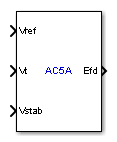AC5A Excitation System
(To be removed) Implements IEEE type AC5A excitation system model
The Specialized Power Systems library will be removed in R2026a. Use the Simscape™ Electrical™ blocks and functions instead. For more information on updating your models, see Upgrade Specialized Power System Models to use Simscape Electrical Blocks.
Library
Simscape / Electrical / Specialized Power Systems / Electrical Machines / Synchronous Machine Control
Description
This block models a simplified brushless excitation system where the regulator is supplied from a permanent magnet generator. This model is good to represent simplified systems with rotating rectifiers.
This block is an adaptation of the AC5A excitation system of the IEEE® 421 standard, copyright IEEE 2005, all rights reserved.
Parameters
Controllers Tab
- Low-pass filter time constant
The time constant Tr of the first-order system representing the stator terminal voltage transducer. Default is
20e-3.- Voltage regulator gain and time constant
The gain Ka and time constant Ta of the first-order system representing the main regulator. Default is
[100 0.02].- Voltage regulator output limits
The voltage regulator output limits VRmin and VRmax, in p.u. Default is
[-7.3 7.3].- Damping filter gain and time constants
The gain Kf and time constants Tf1, Tf, and Tf3 of the second-order system representing the derivative feedback. Default is
[0.03 1 0 0].
Exciter and Rectifier Tab
- Exciter gain and time constant
The gain Ke and time constant Te of the first-order system representing the exciter. Default is
[1.0 0.02].- Field voltage values
The exciter saturation function is defined as a multiplier of exciter alternator output voltage to represent the increase in exciter excitation requirements due to saturation [1]. The saturation function is determined by specifying two voltage points, Efd1 and Efd2 in p.u., on the air-gap line and constant resistance load saturation curve and providing the corresponding two saturation multipliers SeEfd1 and SeEfd2. Default is
[5.6 0.75*5.6].Typically, the voltage Efd1 is a value near the exciter expected maximum output voltage, Efd2 value is about 75% of Efd1.
- Exciter saturation function values
The exciter saturation function is defined as a multiplier of exciter alternator output voltage to represent the increase in exciter excitation requirements due to saturation [1]. The saturation function is determined by specifying two voltage points, Efd1 and Efd2 in p.u., on the air-gap line and Constant Resistance Load saturation curve, and providing the corresponding two saturation multipliers SeEfd1 and SeEfd2. Default is
[0.86 0.5].SeEfd1 and SeEfd2 multipliers are equal to A-B / B, A is the value of exciter field current on the Constant Resistance Load saturation curve corresponding to the selected Efd voltage, and B is the value of exciter field current on the air-gap line corresponding to the selected Efd voltage.
If you do not want to model the saturation effect, set SeVe1 and SeVe2 values to zero.
Initial Values Tab
- Initial values of terminal voltage and field voltage
The initial values of terminal voltage Vt0 and field voltage Efd0, both in p.u. Initial terminal voltage is normally set to 1 pu. The Vt0 and Efd0 values can be determined using the Powergui Load Flow tool. Default is
[1 1].- Sample time
Specify a value greater than zero to discretize the block at the given sample time. Set to -1 to inherit the simulation type and sample time parameters of the Powergui block. Default is
0.
Ports
- Vref
The reference value of the stator terminal voltage, in p.u.
- Vt
The measured value in p.u. of the stator terminal voltage of the controlled Synchronous Machine block.
- Vstab
Connect this input to a power system stabilizer to provide additional stabilization of power system oscillations. When you do not use this option, connect to a Simulink® ground block. The input is in p.u.
- Efd
The field voltage to apply to the
Vfinput of the controlled Synchronous Machine block. The output is in p.u.
References
[1] “IEEE Recommended Practice for Excitation System Models for Power System Stability Studies.” IEEE Standard, Vol. 421, No. 5, 2005 (Revision of IEEE 521.5-1992).
